Too-rapid correction of hyponatremia can cause osmotic demyelination
- Osmotic demyelination syndrome is a risk associated with too-rapid correction of hyponatremia (e.g., >12 mEq/L/24 hours). Osmotic demyelination can result in dysarthria, mutism, dysphagia, lethargy, affective changes, spastic quadriparesis, seizures, coma and death. In susceptible patients, including those with severe malnutrition, alcoholism or advanced liver disease, slower rates of correction may be advisable
- In placebo-controlled clinical trials patients with baseline serum sodium concentration <130 mEq/L:
- At 8 hours, 7% of patients treated with SAMSCA® (tolvaptan) and 1% of patients treated with placebo had serum sodium increase >8 mEq/L
- In the first 24 hours, 2% of patients treated with SAMSCA and 0% of patients treated with placebo had serum sodium increase >12 mEq/L
- Subjects with SIADH or very low baseline serum sodium concentrations may be at greater risk for too-rapid correction of serum sodium
- In patients receiving SAMSCA who develop too-rapid a rise in serum sodium, discontinue or interrupt treatment with SAMSCA and consider administration of hypotonic fluid
- Co-administration of diuretics also increases the risk of too-rapid correction of serum sodium and such patients should undergo close monitoring of serum sodium
Read the recommendations for avoiding osmotic demyelination syndrome during hyponatremia management

The SAMSCA MOA video illustrates the relationship between vasopressin and hyponatremia, as well as the potential benefits of vasopressin V2-receptor antagonism.


